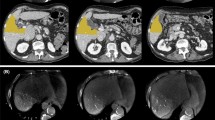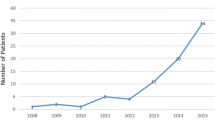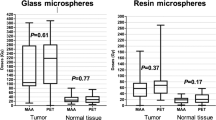Abstract
Purpose
Dose calculation for transarterial radioembolization (TARE) with glass yttrium-90 (Y90) labeled microspheres is based on liver lobe and tumor volumes, currently measured from preprocedural MRI or CT. The variable time between MRI and radioembolization may not account for relevant tumor progression. Advances in cone beam computed tomography (CBCT) allow for intra-procedural assessment of these volumes that avoids this factor. Liver lobe and hepatocellular carcinoma tumor volume measurements and dose calculations using intra-procedural CBCT were compared to those using preprocedural MRI in order to determine feasibility.
Methods
Retrospective analysis was performed in 20 patients with proven hepatocellular carcinoma (HCC) who underwent planning angiography with open trajectory CBCT acquisitions prior to radioembolization, and an MRI performed within 6 weeks prior to treatment planning. Liver lobe and tumor burden volumes were measured based on CBCT using embolization planning and guidance software and measured on preprocedural MRI using standard volume analysis software. Y90 doses were subsequently calculated using each measured volume. Comparisons of volume measurements and calculated Y90 doses between the two modalities were evaluated for significance using paired t tests.
Results
All target liver lobes and all tumors were completely depicted on CBCT. Mean liver lobe and tumor burden volumes measured on intra-procedural CBCT and preprocedural MRI showed no significant difference (p = 0.71). Mean calculated Y90 dose based on each modality showed no significant difference (p = 0.18).
Conclusions
Lobar and tumor volume measurement with CBCT is a reliable alternative to measurement with preprocedural MRI. Utilization of CBCT 3D segmentation software during planning angiography may be useful to provide up-to-date volume measurements and dose calculations prior to radioembolization.


Similar content being viewed by others
References
Benson AB 3rd, D’Angelica MI, Abbott DE, et al. NCCN guidelines insights: hepatobiliary cancers, version 1.2017. J Natl Compr Cancer Netw. 2017;15(5):563–73.
European Association For The Study Of The L, European Organisation For R, Treatment Of C. EASL-EORTC clinical practice guidelines: management of hepatocellular carcinoma. J Hepatol. 2012;56(4):908–43.
Salem R, Gabr A, Riaz A, et al. Institutional decision to adopt Y90 as primary treatment for hepatocellular carcinoma informed by a 1000-patient 15-year experience. Hepatology. 2018;68(4):1429–40.
Sato K, Lewandowski RJ, Bui JT, et al. Treatment of unresectable primary and metastatic liver cancer with yttrium-90 microspheres (TheraSphere): assessment of hepatic arterial embolization. Cardiovasc Interv Radiol. 2006;29(4):522–9.
Biocompatibles, Inventor. TheraSphere.
Miyayama S, Yamashiro M, Okuda M, et al. Usefulness of cone-beam computed tomography during ultraselective transcatheter arterial chemoembolization for small hepatocellular carcinomas that cannot be demonstrated on angiography. Cardiovasc Interv Radiol. 2009;32(2):255–64.
Loffroy R, Lin M, Rao P, et al. Comparing the detectability of hepatocellular carcinoma by C-arm dual-phase cone-beam computed tomography during hepatic arteriography with conventional contrast-enhanced magnetic resonance imaging. Cardiovasc Interv Radiol. 2012;35(1):97–104.
Higashihara H, Osuga K, Onishi H, et al. Diagnostic accuracy of C-arm CT during selective transcatheter angiography for hepatocellular carcinoma: comparison with intravenous contrast-enhanced, biphasic, dynamic MDCT. Eur Radiol. 2012;22(4):872–9.
Miyayama S, Yamashiro M, Hashimoto M, et al. Identification of small hepatocellular carcinoma and tumor-feeding branches with cone-beam CT guidance technology during transcatheter arterial chemoembolization. J Vasc Interv Radiol. 2013;24(4):501–8.
Bapst B, Lagadec M, Breguet R, Vilgrain V, Ronot M. Cone Beam Computed Tomography (CBCT) in the field of interventional oncology of the liver. Cardiovasc Interv Radiol. 2016;39(1):8–20.
Miyayama S, Yamashiro M, Ikuno M, Okumura K, Yoshida M. Ultraselective transcatheter arterial chemoembolization for small hepatocellular carcinoma guided by automated tumor-feeders detection software: technical success and short-term tumor response. Abdom Imaging. 2014;39(3):645–56.
Louie JD, Kothary N, Kuo WT, et al. Incorporating cone-beam CT into the treatment planning for yttrium-90 radioembolization. J Vasc Interv Radiol. 2009;20(5):606–13.
Miyayama S, Yamashiro M, Hashimoto M, et al. Comparison of local control in transcatheter arterial chemoembolization of hepatocellular carcinoma </=6 cm with or without intraprocedural monitoring of the embolized area using cone-beam computed tomography. Cardiovasc Interv Radiol. 2014;37(2):388–95.
Bruix J, Sherman M, American Association for the Study of Liver D. Management of hepatocellular carcinoma: an update. Hepatology. 2011;53(3):1020–2.
Lewandowski RJ, Sato KT, Atassi B, et al. Radioembolization with 90Y microspheres: angiographic and technical considerations. Cardiovasc Interv Radiol. 2007;30(4):571–92.
Tacher V, Radaelli A, Lin M, Geschwind JF. How I do it: cone-beam CT during transarterial chemoembolization for liver cancer. Radiology. 2015;274(2):320–34.
Tacher V, Lin M, Chao M, et al. Semiautomatic volumetric tumor segmentation for hepatocellular carcinoma: comparison between C-arm cone beam computed tomography and MRI. Acad Radiol. 2013;20(4):446–52.
Chapiro J, Lin M, Duran R, Schernthaner RE, Geschwind JF. Assessing tumor response after loco-regional liver cancer therapies: the role of 3D MRI. Expert Rev Anticancer Ther. 2015;15(2):199–205.
Siegel JA, Thomas SR, Stubbs JB, et al. MIRD pamphlet no. 16: techniques for quantitative radiopharmaceutical biodistribution data acquisition and analysis for use in human radiation dose estimates. J Nucl Med. 1999;40(2):37S–61S.
Schernthaner RE, Chapiro J, Sahu S, et al. Feasibility of a modified cone-beam CT rotation trajectory to improve liver periphery visualization during transarterial chemoembolization. Radiology. 2015;277(3):833–41.
Meyer BC, Frericks BB, Voges M, et al. Visualization of hypervascular liver lesions during TACE: comparison of angiographic C-arm CT and MDCT. AJR Am J Roentgenol. 2008;190(4):W263–9.
Funding
This study was not supported by any funding.
Author information
Authors and Affiliations
Corresponding author
Ethics declarations
Conflict of interest
Imramsjah Martijn van der Bom is employed by Philips Healthcare. Alessandro Radaelli is employed by Philips Healthcare. Edward Kim is a member of the Scientific Advisory Board: Boston Scientific Corp. He has also spoken for industry-sponsored lectures: BTG International Ltd. and Philips Healthcare.
Ethical Approval
For this type of study (retrospective analysis), formal consent is not required. This retrospective analysis was performed under an Institutional Review Board (IRB) approved protocol.
Informed Consent
For this type of study, informed consent is not required. This study has obtained IRB approval, and the need for informed consent was waived.
Additional information
Publisher's Note
Springer Nature remains neutral with regard to jurisdictional claims in published maps and institutional affiliations.
Rights and permissions
About this article
Cite this article
O’Connor, P.J., Pasik, S.D., van der Bom, I.M. et al. Feasibility of Yttrium-90 Radioembolization Dose Calculation Utilizing Intra-procedural Open Trajectory Cone Beam CT. Cardiovasc Intervent Radiol 43, 295–301 (2020). https://doi.org/10.1007/s00270-019-02198-6
Received:
Accepted:
Published:
Issue Date:
DOI: https://doi.org/10.1007/s00270-019-02198-6




